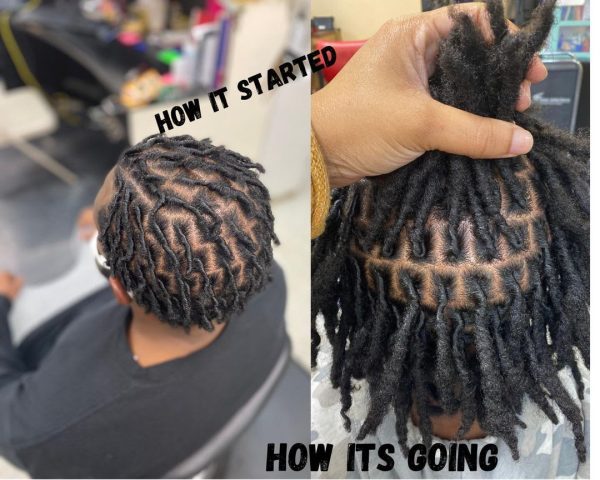
Dreadlocks have gained popularity as a hairstyle because of their distinctive coiled texture and symbolic significance. But with dreadlocks, growth isn’t always obvious like it is with loose hair. For individuals who wish for long, flowing locs, this may be frustrating. Beyond the dreadlocks’ cultural importance and attractive appearance is the interesting journey of dreadlock hair growth.
Understanding Dreadlock Hair Growth
Dreadlocks require a little more time and effort to acquire noticeable length than traditional hairstyles, where hair grows naturally from the scalp. Over time, the hair naturally tangles and locks together to form dense, knotted strands that grow out of the scalp. This is how dreadlocks form. However, the rate of hair growth for dreadlocks may differ from person to person due to factors such as genetics, hair type, and maintenance routine.
Patience is a key component in the growth of dreadlock hair. Compared to other hairstyles that could yield instant results, dreadlocks need time to develop and grow. It’s critical to enjoy the journey and fight the urge to hasten the growth of your dreadlocks. Your dreadlocks will eventually grow into beautiful, flowing strands that showcase your patience and devotion if you give them regular attention.
Dreadlock Growth Myth
Dreadlock growth may appear to be a slow process. As a result, various myths regarding what encourages and discourages healthy dreadlock growth have started to spread. Let’s dispel some of the most widespread misconceptions about dreadlock growth and get the facts straight!
Myth 1: Hanging Upside Down Makes Your Hair Grow Faster
Though it’s an entertaining tale, there isn’t any scientific proof for it. Not gravity, but rather scalp health and heredity are the main determinants of hair growth. While hanging upside down might give you a temporary feeling of increased blood flow to the scalp, it won’t have any lasting impact on hair growth rate.
Myth 2: Some Foods Specifically Encourage Dreadlock Growth
Although eating a well-balanced diet full of vital vitamins and minerals is important for good health in general, no one food can promise faster hair growth. Vitamins A, C, and E, as well as biotin, are necessary for strong hair, but they won’t cause dreadlock growth to appear overnight. To fuel your body and support the health of your hair generally, concentrate on eating a balanced diet that includes lots of fruits, vegetables, and whole grains.
Myth 3: Tight Retwists Support Faster Growth
Overtwisting can restrict growth, even though it’s necessary to keep your dreadlocks intact and in shape. Continuous strain can cause breakage and damage to the hair at the root. Depending on your growth rate, aim for retwists every 4–8 weeks. Use a light touch to prevent overstressing the locs.
Myth 4: Washing Your Dreadlocks Slows Growth
This myth has the potential to be quite harmful. Like any other hair type, dreadlocks require routine washings to get rid of product buildup, sweating, and dirt. A healthy scalp is necessary for the growth of hair. Depending on how active you are and the state of your scalp, wash your dreads every one to two weeks using a mild, sulfate-free shampoo.
Myth 5: Healthy loc growth requires routine scalp treatments
Although they can help support blood circulation and scalp health, natural oils like jojoba oil and scalp massages aren’t a surefire way to accelerate growth. For best results in growth of hair, keep your scalp clean by regularly washing it and eating a balanced diet.
The Truth About Dreadlock Growth
The reality is, that healthy dreadlock growth comes down to a good dreadlock care routine. Here are some key practices to follow:
- A healthy scalp is crucial for hair growth, and regular cleansing and scalp massages can help remove buildup and promote blood circulation
- Deep conditioning is essential for Dreadlocks, as they crave moisture and growth.
- A balanced diet rich in vitamins and minerals, such as biotin and vitamins A, C, and E, is also beneficial.
- Heat styling tools should be minimized, and regular retwisting is essential to incorporate new growth and maintain shape, but avoid over-twisting to prevent breakage.
- Protective styling, such as wearing a satin or silk scarf or cap, can minimize friction and prevent breakage.
Frequently Asked Questions and Answers About Dreadlock Hair Growth
1. Do dreadlocks grow faster or slower than regular hair?
Dreadlocks grow at a similar rate to regular hair, but the locking and matting process can make growth less noticeable. Genetics, hair type, and maintenance routine also affect dreadlock hair growth.
2. How long does it take for dreadlocks to grow?
Dreadlock growth time varies, with an average of half an inch per month, requiring several months or years to achieve significant length.
3. Can I speed up dreadlock hair growth?
Maintaining a healthy scalp and hair care routine, including regular washing, moisturizing, and gentle maintenance, can promote optimal hair growth from the roots.
4. Do dreadlocks get longer as they mature?
Yes, Dreadlocks grow longer as hair grows from the scalp, adding length to existing locks, and resulting in longer, more mature-looking locks over time.
5. Can I trim my dreadlocks to encourage growth?
Dreadlock trimming can enhance hair growth by removing split ends, but it’s crucial to do it sparingly and only when necessary to avoid unnecessary length loss.
6. What should I eat to promote healthy dreadlock hair growth?
A balanced diet rich in protein, vitamins, and minerals is crucial for healthy hair growth, including dreadlocks, and should include lean proteins, fruits, vegetables, and whole grains.
7. How can I prevent breakage and thinning in my dreadlocks?
Avoid excessive manipulation, harsh styling, and tight hairstyles to prevent breakage and thinning in dreadlocks. Maintain a healthy scalp and proper hydration for strong, resilient hair.
8. Do dreadlocks require special care to encourage growth?
Dreadlocks require regular washing, moisturizing, and gentle maintenance to promote healthy hair growth and maintain their integrity, despite their unique care requirements compared to other hairstyles.
Conclusion
Dreadlock hair growth is a natural process that requires patience, care, and dedication. By understanding the factors that influence hair growth, adopting a healthy hair care routine, and embracing the journey, you can encourage optimal growth and achieve long, luscious dreadlocks that reflect your unique style and personality.

Leave a Reply